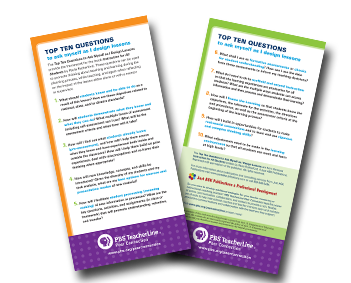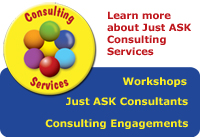
Volume VII Issue II
Share this newsletter on
Dropouts: Our Ultimate Left Behind Children

Bruce facilitating a Leading the Learning® workshop
A newspaper ad for a new film titled Ten9Eight included the following statement: “In America a kid drops out of school every nine seconds.” I found that statement to be surprising and alarming so I decided to investigate the dropout issue in more detail. I found multiple sources of data including the National Dropout Prevention Center, the Alliance for Excellent Education, the National Reading Panel, and testimony before the U.S. House of Representatives Education and Labor Committee.
My data review revealed these facts:
- Nationwide, 7,000 students drop out of school each day.
- Only about 70% of students graduate from high school with a standard diploma.
- The graduation rate in the 50 largest U. S. cities is only 53%.
- 59% of federal prison inmates did not complete high school and 75% of America’s state prisoners are dropouts.
- U.S. companies lose nearly $40 billion annually because of illiteracy.
- Students with disabilities drop out of school at over twice the rate of their peers of the same age.
- A dropout earns $260,000 less over a lifetime when compared with a high school graduate.
- Dropouts have poorer health conditions and lower life expectancy.
- Cutting the dropout rate in half would result in $45 billion annually in new federal tax revenues or cost savings.
The overall impact on individual dropouts is summarized by education writer Anne Nelson who writes, “Dropping out of high school today is to your societal health what smoking is to your physical health – an indicator of a host of poor outcomes to follow, from low lifetime earnings to high incarceration rates to a high likelihood that your children will drop out of high school and start the cycle anew.” Additionally, economists have surmised that the high school dropout crisis threatens the U.S. economic growth and competitiveness in a world market. The U.S. Department of Labor has predicted that 90% of future high-growth and high-wage jobs will necessitate some level of postsecondary education. Putting it another way, the world is rapidly changing and there will be little or no employment for an individual without a high school diploma. In short, the problem is huge.
The bleak picture surrounding the dropout crisis led me to investigate how individual schools and school districts are addressing the problem. There is an abundance of resources, suggestions, proposals, and initiatives online at numerous websites. I also found that the problem is not being ignored as many cities and school districts have programs in place to curb the high rate of dropping out. The more I read, the more I wanted to know about how the problem became one of such magnitude and how more could be done to reduce the number of dropouts.
Early Signals at the Elementary Level
Many children send strong distress signals early in their educational years. Anne Nelson describes the process with the term “slow disengagement.” These early indicators include poor or sporadic attendance, missing homework, low or failing grades, and struggles with literacy. If these warning signs go unheeded, the likelihood of a student becoming mired in failure is substantially greater. In response to these signs, many schools initiate targeted interventions during which professionals or paraprofessionals work with students in small groups or in one-on-one settings. At the first signs of possible attendance problems or academic struggles, these schools react quickly to put support systems in place and work closely with parents to ensure that the student comes to school regularly.
A number of research studies on elementary school dropouts have been completed. Interventions that are frequently recommended include:
- Increased parental involvement
- Insurance that student basic needs such as free or reduced meals, school supplies, clothing, etc. were being provided
- Inclusion of early developmental and preschool programs
- Use of more formative assessment data in order to modify instructional efforts
- Implementation of effective early reading programs
- Interventions to address specific learning or behavioral problems
- Implementation of tutoring and mentoring programs using both peers as well as adults
- Use of positive reinforcement techniques and attribution retraining to change student attitudes toward themselves as well as school in general
- Offering programs beyond the school day or school year to improve academic skills
- Using culturally sensitive instructional strategies across all classrooms
Middle and High School Practices
One of the most basic warning signs at the secondary level that a student may become a dropout is the lack of literacy skills. When a student spends the school day struggling to read material that is beyond his comprehension, giving up seems like the only option. Many teens get behind in their work and then feel they have no chance of catching up so they leave school entirely. For others, as their work habits deteriorate, their absences increase. Still other young people are trying to cope with all-consuming life experiences and going to school takes a back seat to day-to-day survival. Ninth grade seems to be a pivotal point in the lives of potential dropouts; their success or lack of success is key to whether they will end up dropping out of school.
Researchers, educators, sociologists, and psychologists have made recommendations for practices that may be effective in addressing the dropout problem that apply more specifically to middle and high school students. The practices, which are written about in great detail in studies as well as on the Internet, include the following ideas:
- Determine early on who is at risk by putting into place useful and practical data systems to identify potential students at risk
- Identify struggling students immediately and have in place programs such as the pyramid of interventions suggested by Rick DuFour in his work with professional learning communities
- Focus on the development of literacy skills
- Ensure that systems that are in place are viewed as supportive and not punitive by students
- Assign adult advocates/mentors to work with struggling students
- Build relationships with individual students by personalizing the learning environment and the instructional practices
- Develop truancy prevention programs as well as re-enrollment initiatives that bring dropouts back into the school setting
- Avoid falling prey to the “ups and downs of adolescence” excuse when students begin slacking off or stop working entirely
- Establish partnerships with community organizations and health centers and publicize the existence of these school/community relationships
- Ensure that all staff members are on board with a “you can make it” attitude that is not simply lip service but evidenced in their professional behavior
- Investigate the feasibility of instituting initiatives such as Education 2020, an on-line, credit retrieval program to help students meet graduation requirements
- Keep students abreast of their potential graduation standing in order to avoid a phenomena called “last-minute dropouts” when students are caught off guard and are seemingly unaware of required courses or work yet to be completed
- Periodically assess the effectiveness of initiatives and make adjustments when necessary
Schoolwide Initiatives and Vertical Articulation
In this age of accountability and emphasis on standards, some districts and individual schools use grade retention as an intervention when students have academic deficits. However, a century of research has concluded that retention is ineffective in addressing a student’s lack of academic progress. Research on the subject shows that as many as 15% of students in the U.S. are held back every year and that between 30% and 50% of students are retained at least once prior to reaching high school with the highest retention rates occurring among poor, minority, or inner-city youth. Recent studies have shown that retention is one of the most reliable predictors of a high school dropout. In addition, with the establishment of promotion standards, the practice of “social promotions” is being discouraged or eliminated entirely. Trying to find alternatives to deal with this difficult dilemma can be a frustrating experience for educators.
In order to effectively address the problem, it is essential that individual schools as well as groups of schools within a district or attendance area discuss the problem openly and honestly and devise approaches to stem the tide of dropping out of school. The term “vertical articulation” is used to describe the scope and sequence students experience in each curriculum area as they move through the K-12 educational structure. An extension of the process should include clear communication about students who are struggling academically so as to prevent the possibility of retention or dropping out of school. Not only must there be detailed communication between grades at each level, there should be precise and specific information shared when students move from elementary to middle and then on to high school. The information should include support programs that were successful as well as practices that were less than effective. When this information is transmitted, the receiving teacher(s) have a better idea of where to start and what practices to avoid with each individual child. All staff members should be knowledgeable about and be able to explain how they are implementing the school’s dropout prevention initiatives.
Student Perspectives
Often when we struggle with a problem, we sometimes fail to see the obvious. When current or potential dropouts are asked for their perspectives on how schools can keep more students from dropping out, they provide some thought-provoking ideas. Some of their suggestions are:
- Provide more support to build literacy skills
- Use more varied instructional delivery methods instead of lecturing
- Have more one-on-one help and alternative ways to access support such as Saturday classes and summer programs
- Establish a closer connection between school and the world of work
- Make classroom experiences more relevant and engaging
- Arrange for more real-world experiences such as service learning or internships
- Accept me as I am and do not assume that I have the necessary skills or knowledge to succeed in your class
- View me as an individual and not as part of a data system
Busy educators are always seeking resources that can help them accomplish their incredibly difficult and multi-layered job of successfully educating our youth. I highly recommend Paula Rutherford’s latest book, Meeting the Needs of Diverse Learners. It is an easy-to-use, excellent resource filled with specific, practical ideas, suggestions, and strategies to address the learning needs of all learners. A standout in the book is the section titled “Literacy Across the Curriculum” that includes practical ways to support the development of literacy skills in our students.
I have not yet seen Ten9Eight but I have read a synopsis of the film. It tells the story of a business plan competition that had 24,000 applicants from across the country including many inner city youth. Included in the film are success stories about “remarkably resilient kids” who defied the odds, stayed in school, and have potential bright futures. As any educator knows, there is not one solution that will address the dropout problem. Schools, however, must be fluid, creative, responsive, and humane in order to prepare our students for an ever-changing world. Through a concerted effort we can reverse the dropout trend so that our young people are not left behind to face a life of struggles and hardships.
Permission is granted for reprinting and distribution of this newsletter for non-commercial use only. Please include the following citation on all copies:
Oliver, Bruce. “Dropouts: Our Ultimate Left Behind Children.” Just for the ASKing! January 2010. Reproduced with permission of Just ASK Publications & Professional Development (Just ASK). © 2010 Just ASK. All rights reserved. Available at www.justaskpublications.com.
Free Top Ten Tips to Ask Myself as I Design Lessons
“These questions can be used to promote thinking about teaching and learning during the planning process, while teaching, and again when reflecting on the impact of the lesson either alone or with a mentor or supervisor.”




